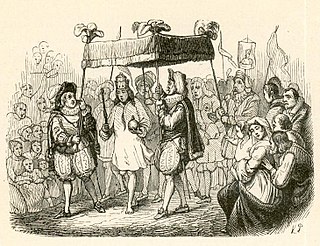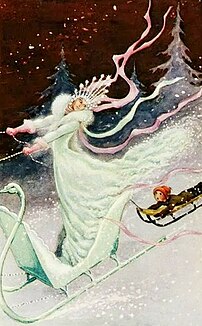 W
W"The Angel" is a literary fairy tale by Hans Christian Andersen about an angel and a dead child gathering flowers to carry to Heaven. The tale was first published with three others in New Fairy Tales by C.A. Reitzel in November 1843. The four tales were received by the Danish critics with great acclaim. A print depicting the angel and child became very popular.
 W
W"Blockhead Hans" is a literary fairy tale by Hans Christian Andersen. It was first published in Danish in 1855. An early English translation appeared in Andrew Lang's 1894 The Yellow Fairy Book, although Lang gave no source for the tale. The tale has been variously translated as "Clumsy Hans", "Silly Hans" and "Jack the Dullard". It is number 119 in the Hans Christian Andersen Centre's register of Andersen's literary works.
 W
WThe dragon and daughter is a Danish folktale.
 W
W"The Elf Mound" is a literary fairy tale by Danish poet and author Hans Christian Andersen (1805–1875). The tale is about a feast held in an elf mound for the Goblin Chief of Norway and his two sons, both of whom are expected to select elf brides. The tale was published in Copenhagen, Denmark by C.A. Reitzel in April 1845.
 W
W"The Emperor's New Clothes" is a literary folktale written by Danish author Hans Christian Andersen, about a vain emperor who gets exposed before his subjects. The tale has been translated into over 100 languages.
 W
W"The Flying Trunk" is a literary fairy tale by the Danish poet and author Hans Christian Andersen about a young man who has a flying trunk that carries him to Turkey where he visits the Sultan's daughter. The tale was first published 1839.
 W
W"The Garden of Paradise" is a literary fairy tale by Hans Christian Andersen first published by C. A. Reitzel in Copenhagen, Denmark on 19 October 1839 with "The Flying Trunk" and "The Storks" in the second booklet of Fairy Tales Told for Children. New Collection. King Max read and liked the tale. Andersen biographer Jackie Wullschlager considers the story and its two companion pieces in the booklet as "grim". "The Garden of Paradise" ends with Death approaching a young prince and warning him to expiate his sins for, one day, he will come for him and "clap him in the black coffin".
 W
W"The Goblin at the Grocer's" is a fairy tale published 1852 by Danish author Hans Christian Andersen, about a goblin who must choose between poetry or his Christmas porridge from a grocer.
 W
W"Golden Treasure" is a literary fairy tale by Danish poet and author Hans Christian Andersen.
 W
W"The Ice-Maiden" is an 1861 literary fairy tale by the Danish writer Hans Christian Andersen. The first English translation was published by King and Baird in 1863.
 W
W"The Little Match Girl" is a literary fairy tale by Danish poet and author Hans Christian Andersen. The story, about a dying child's dreams and hope, was first published in 1845. It has been adapted to various media, including animated and live-action films, television musicals, and video games.
 W
W"The Little Mermaid" is a literary fairy tale written by the Danish author Hans Christian Andersen. The story follows the journey of a young mermaid who is willing to give up her life in the sea as a mermaid to gain a human soul. The tale was first published in 1837 as part of a collection of fairy tales for children. The original story has been a subject of multiple analyses by scholars such as Jacob Bøggild and Pernille Heegaard as well as the folklorist Maria Tatar. These analyses cover various aspects of the story from interpreting the themes to discussing why Andersen chose to write a tragic story with a happy ending. It has been adapted to various media, including musical theatre, anime, ballet, opera, and film. There is also a statue portraying the mermaid in Copenhagen, Denmark, where the story was written and first published.
 W
W"Ole Lukøje" is a literary fairy tale by Hans Christian Andersen based upon a folk tale telling of a mysterious mythic creature of the Sandman who gently takes children to sleep and, depending on how good or bad they were, shows them various dreams.Under each arm he carries an umbrella; one of them, with pictures on the inside, he spreads over the good children, and then they dream the most beautiful stories the whole night. But the other umbrella has no pictures, and this he holds over the naughty children so that they sleep heavily, and wake in the morning without having dreamed at all.
 W
W"The Princess and the Pea" is a literary fairy tale by Hans Christian Andersen about a young woman whose royal identity is established by a test of her sensitivity. The tale was first published with three others by Andersen in an inexpensive booklet on 8 May 1835 in Copenhagen by C. A. Reitzel.
 W
W"The Red Shoes" is a literary fairy tale by Danish poet and author Hans Christian Andersen first published by C.A. Reitzel in Copenhagen 7 April 1845 in New Fairy Tales. First Volume. Third Collection. 1845.. Other tales in the volume include "The Elf Mound" (Elverhøi), "The Jumpers" (Springfyrene), "The Shepherdess and the Chimney Sweep", and "Holger Danske".
 W
WThe Shadow is a literary fairy tale by Danish poet and author Hans Christian Andersen. The tale was first published in 1847.
 W
W"The Snow Queen" is an original fairy tale by Danish author Hans Christian Andersen. It was first published 21 December 1844 in New Fairy Tales. First Volume. Second Collection. 1845. The story centres on the struggle between good and evil as experienced by Gerda and her friend, Kai.
 W
W"The Swineherd" is a literary fairy tale by Hans Christian Andersen about a prince who disguises himself as a swineherd to win an arrogant princess. The tale was first published December 20, 1841 by C. A. Reitzel in Copenhagen, Denmark in Fairy Tales Told for Children. New Collection. The tale appears to be original with Andersen though similar tales are known. "The Swineherd" has been adapted to various media.
 W
WThumbelina is a literary fairy tale written by Danish author Hans Christian Andersen first published by C. A. Reitzel on 16 December 1835 in Copenhagen, Denmark, with "The Naughty Boy" and "The Travelling Companion" in the second instalment of Fairy Tales Told for Children. Thumbelina is about a tiny girl and her adventures with marriage-minded toads, moles, and cockchafers. She successfully avoids their intentions before falling in love with a flower-fairy prince just her size.
 W
W"The Ugly Duckling" is a literary fairy tale by Danish poet and author Hans Christian Andersen (1805–1875). “The Ugly Duckling” was first published on 11 November 1843, with three other tales by Andersen in Copenhagen, Denmark to great critical acclaim. The tale has been adapted to various media including opera, musical, and animated film. The tale is completely Andersen's invention and owes no debt to fairy tales or folklore.
 W
WThe Wild Swans is a literary fairy tale by Hans Christian Andersen about a princess who rescues her 11 brothers from a spell cast by an evil queen. The tale was first published on 2 October 1838 as the first installment in Andersen's Fairy Tales Told for Children by C. A. Reitzel in Copenhagen, Denmark. It has been adapted to various media including ballet, television, and film.